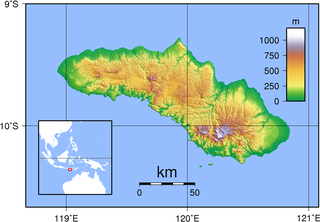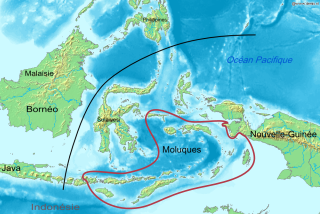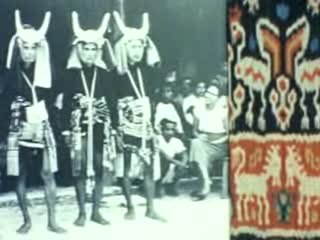Related Research Articles

Sumba is an island in eastern Indonesia. It is one of the Lesser Sunda Islands and is in the province of East Nusa Tenggara. Sumba has an area of 11,006.62 square kilometres, and the population was 779,049 at the 2020 Census. To the northwest of Sumba is Sumbawa, to the northeast, across the Sumba Strait, is Flores, to the east, across the Savu Sea, is Timor, and to the south, across part of the Indian Ocean, is Australia.
The Marapu religion is a form of ancestral religion that is practiced mainly in the island of Sumba in Indonesia. Marapu is also practiced in many more remote areas of Sumba and Flores. Both the Christians and Muslims on these islands tend to combine their faiths with Marapu. Since Marapu, like Kaharingan of the Dayaks, is not an official religion of Indonesia, and all Indonesian citizens are required to identify as a member of one of the religions sanctioned by law, members have chosen either Christianity or Islam to self identify.

Suðuroy is the southernmost of the Faroe Islands. The island covers 163.7 square kilometres (63.2 sq mi). In 2018 the population was 4,601. Suðuroy region (sýsla) comprises this island and Lítla Dímun, the next isle northward in the Faroes, which is uninhabited.

Sumba is the southernmost village of the Faroe Islands, located on the island of Suðuroy. It is located in Sumbiar Municipality.

The Central Malayo-Polynesian languages (CMP) are a proposed branch in the Malayo-Polynesian subgroup of the Austronesian language family. The languages are spoken in the Lesser Sunda and Maluku Islands of the Banda Sea, in an area corresponding closely to the Indonesian provinces of East Nusa Tenggara and Maluku and the nation of East Timor, but with the Bima language extending to the eastern half of Sumbawa Island in the province of West Nusa Tenggara and the Sula languages of the Sula archipelago in the southwest corner of the province of North Maluku. The principal islands in this region are Sumbawa, Sumba, Flores, Timor, Buru, and Seram. The numerically most important languages are Bima, Manggarai of western Flores, Uab Meto of West Timor, and Tetum, the national language of East Timor.

Manupeu Tanah Daru National Park is located on the island of Sumba in Indonesia. This national park consists lowland forests on steep slopes that rise up to ca. 600m.
Laiwangi Wanggameti National Park is located on the island of Sumba in Indonesia. All forests types that exist on this island can be found in this national park. Some endemic plant species are protected in this national park, such as Syzygium species, Alstonia scholaris, Ficus species, Canarium oleosum, Cinnamomum zeylanicum, Myristica littoralis, Toona sureni, Sterculia foetida, Schleichera oleosa, and Palaquium obovatum.

West Sumba Regency is a regency in East Nusa Tenggara Province of Indonesia. Established in 1958, the regency was considerably reduced in 2007 with the creation of new Regencies on Sumba Island. Its area is now 737.42 km2, and its population was 111,993 at the 2010 census and 145,097 at the 2020 Census. It has its seat (capital) in (Kota) Waikabubak.

Central Sumba Regency is a regency in East Nusa Tenggara of Indonesia. The new Central Sumba Regency was established when West Sumba Regency was split into two regencies in 2007 and a further Regency was created in Central Sumba from parts of both West Sumba and East Sumba Regencies. The new Regency covers 1,869.18 km2 and had a population of 62,485 at the 2010 Census and 85,482 at the 2020 Census. The seat (capital) of its government is located at Waibakul.
The Sumba–Hawu languages are a group of closely related Austronesian languages, spoken in East Nusa Tenggara, Indonesia.
The Sumba–Flores languages, which correspond to the traditional "Bima–Sumba" subgroup minus Bima, are a proposed group of Austronesian languages spoken on and around the islands of Sumba and western–central Flores in the Lesser Sundas. The main languages are Manggarai, which has half a million speakers on the western third of Flores, and Kambera, with a quarter million speakers on the eastern half of Sumba Island.

The textiles of Sumba, an island in eastern Indonesia, represent the means by which the present generation passes on its messages to future generations. Sumbanese textiles are deeply personal; they follow a distinct systematic form but also show the individuality of the weavers and the villages where they are produced. Internationally, Sumbanese textiles are collected as examples of textile designs of the highest quality and are found in major museums around the world, as well as in the homes of collectors.
Kodi is a Sumba language of Indonesia. The population figure may include Gaura, which Ethnologue counts as a dialect of both the Lamboya and Kodi languages. Kodi is an Austronesian language that is mainly spoken in Nusa Tenggara Timur province, the western part of the island of Sumba in eastern Indonesia. An alternate name for Kodi is Kudi and dialects of the language include Kodi Bokol, Kodi Bangedo, Nggaro (Nggaura) and is most alike to Wejewa. With only approximately 20,000 speakers, the Kodi language is an endangered language.
Baliledu is an Austronesian language spoken on Sumba, Indonesia.
Christian Church of Sumba is Calvinist church in Indonesia, a member of World Communion of Reformed Churches. The denomination was established on 15 January 1947. Today, the church has congregations in various cities outside the island of Sumba.

Kabeala is a traditional weapon originating from East Sumba, Indonesia.

The Sumba people are an ethnic group inhabiting Sumba Island in Indonesia, which is divided by two regencies, namely West Sumba Regency and East Sumba Regency. They refer to themselves as Tau Humba. The Sumbese have been able to retain much of their culture despite foreign influences that arrived long ago on the Lesser Sunda Islands.

The Sumba languages are a subgroup of the Austronesian language family, spoken on Sumba, an island in eastern Indonesia. They are closely related to the Hawu–Dhao languages.
Sumbe is an ancient settlement in the Almaty region, Kazakhstan.
References
- ↑ Blust, Robert (2008). "Is There a Bima-Sumba Subgroup?". Oceanic Linguistics. 47 (1): 45–113. doi:10.1353/ol.0.0006. JSTOR 20172340.